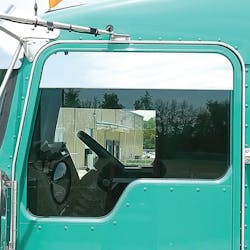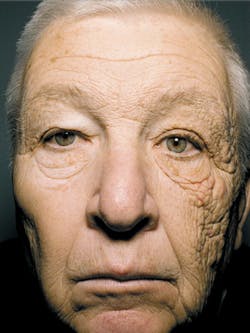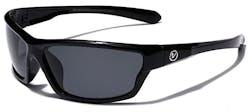Truck driver Bill McElligott may have the world's most famous left side of a face.
Five years ago his photo was featured in the New England Journal of Medicine, accompanying a story about Unilateral Dermatoheliosis – damage to skin on half of his face caused by ultraviolet (UV) rays from the sun.
Photos of the 69-year old truck driver – who had been on the road for 28-years – were shown by hundreds of media outlets throughout the world and prompted a rush by many people, especially truckers, to learn how they can protect themselves.
Unfortunately, many drivers still aren't taking the proper precautions against UV rays, because they believe that UV rays can't penetrate window glass (some do and some don't), they've tinted their windows (which don't always protect against sun damage) and they wear sunglasses while behind the wheel (they may not have the right kind).
The sun emits three kinds of UV rays, all of which are invisible: UV-A is the most damaging to skin and eyes; UV-B rays are less damaging, and UV-C rays are absorbed by the atmosphere and thus not a factor.
For the most part, UV-B rays cannot penetrate glass so a trucker who keeps the side window closed on his or her vehicle is protected from them while driving.
But what many drivers don’t know is that each type of window glass in their truck cabs offers different levels of protection against the more dangerous UV-A rays.
By federal mandate, trucks must adhere to the same glass standards as cars. The front and back windows must be laminated glass; a “sandwich” made of glass-plastic-glass layered atop one another.
Upon impact, that type of glass turns into a spider web of cracks that protect the driver from glass fragments – but it also offers protection against UV rays, according to Dr. Brian Boxer Wachler.
“That plastic film is where the UV protection is and that’s what also makes the window shatter proof,” he said. “In our study we found that UV protection of the front windshield was on average 96%.”
That study, published in the May 12, 2016 edition of the Journal of the American Association Ophthalmology, tested 29 automobiles and assessed their UV protection.
However, Wachler noted that side windows in automobiles are crafted from tempered glass; designed to shatter into tiny, benign pieces upon impact. But they also let in a lot more UV rays – on average about 71% more. "This explains why we see a lot more damage to the left side of the face, including eye damage," he explained.
What about tinted windows? Trucks are allowed to have tinted windows provided that 70% of the normal light is transmitted.
"Some tints will have really good UV protection, but not all do,” Wachler stressed. “Drivers cannot assume that if they have tinted windows that they are protected from UV.”
He added that if you want to tint your windows, make sure to get tinting that offers high UV protection.
Wachler offers a free, reusable card that allows drivers to check the UV exposure in their cabs: Click here for it.
"We have sent out thousands of them," he noted.As for sunglasses, UV protection is not an issue but style is. "The good news about sunglasses is that, by law, sunglasses must offer a very high level of UV protection, so it doesn’t really matter if they’re expensive or cheap sunglasses," he emphasized.
Wachler pointed out, though, that the key to sunglass protection is the frame.
"It should be a wrap-around, versus a wayfarer type of frame, which is just straight. You should get the kind that hugs your face like some of the sports-types,” he said. “Wraparounds prevent the sun from sneaking around the edge of the frames and hitting your eyes."
(By placing the UV card behind sunglasses, you can test their protection, too.)
Wachler also noted that drivers should wear sunscreen and a hat to keep the sun from hitting their forehead and the rest of their face.
While most people know about the sun's skin cancer-causing rays, they may be less familiar with eye damage caused by UV rays.
First, prolonged sun can cause an increase in cataracts and macular degeneration, Wachler explained: "Once cataracts develop there’s really no way to treat it other than surgery."
Another sun-caused malady is keratoconus, a disease in which collagen in the cornea is made weaker. "We definitely see people, including truck drivers, who come in with keratoconus; it’s much more common than everybody thinks; about 1 in 500 people,” he said. “So we are able, with a procedure that I developed, to improve people’s vision so that they can keep their job, which is being a truck driver.”
Still another disease is pterygium, which is a fleshy growth on the white of the eye that becomes very red and can grow onto the cornea and cause vision problems,” Wachler noted.
In conclusion, he noted that most people still maintain a perception that if they’re in their car or truck, then they’re protected from the sun’s UV rays.
“I, myself, an eye specialist, thought this before we did the study," Wachler noted, who is also the author of a book Perceptual Intelligence, which delves into why people receive and interpret information differently. "It’s such an interesting phenomenon between what people perceive and what is reality."
About the Author

Larry Kahaner
Larry Kahaner is an author, journalist, and former FleetOwner contributor.


